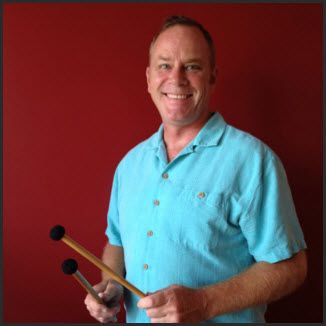A firm relaxed grip that allows for the wrist to move freely is what makes a good timpani mallet grip. I play with what is generally referred to as the French Grip or really the American Grip. The profile of this grip is that the palms of your hands face each other and that your thumbs are on top as opposed to the side.
The mallet is held in a relaxed grip between your thumb and fore finger with the other fingers nestled underneath in contact with the stick. To play with this grip your wrist does the work except in rare circumstances when the fingers are employed for very soft playing for example. But, in general, the mallet and wrist move as one unit.
The challenge for every player is to let the mallet rebound freely once it makes contact with the drum head and not to have the mallet “stick” to the head for any length of time.
Your body position is very important as well as your grip on the mallet. I sit to play the timpani because I am over six feet tall and for most drums I’m too tall to play without having to bend my knees and back in order to play comfortably.
Sitting at the drums puts me in a good position so that my hands aren’t too far from the drums and that I’m able to have my back straight. Having a straight back and good posture are very important especially if you are playing a long concert. Sitting with my back straight allows me to look comfortably at the drums, the music stand and the conductor without having to bend awkwardly which might put a strain on my neck or back.
Sitting at the drums will also allow me to keep my feet on or at the ready to work the tuning pedals. I want to be able to adjust the pitch of the drums whenever necessary and I want to be able to do this quickly and without a whole lot of extra body movement.
Take a look at this video where I show the grip and demonstrate how to sit at the drums.
Getting a good sound from timpani requires the player to not only play the drum on the correct playing spot but to also have the proper striking technique with the mallet. Remember; the best playing spot on the timpano is about 3 inches from the rim of the drum and directly in front of the player. When striking the drum it is important that the mallet come off the head smoothly as if it were not even being held by the player.
Here is a fun experiment that can help you develop a smooth timpani stroke:
Here’s how to do it yourself:
- Use a ball style timpani mallet instead of a cartwheel mallet
- Hold the mallet vertically by the handle with the ball about 18 inches or so over the playing spot on the drum
- Drop the mallet straight down and catch it as it bounces from the drum. As you repeat this drop and catch pay close attention to the stick’s motion as it drops and as it rebounds. Also, concentrate on the tone the dropped mallet makes. This is pure round timpani sound which is what you are going to try and achieve while holding the mallet in a playing position
- The dropped stick falls naturally and rebounds without hesitation
- Now, use your timpani stick grip and play the drum. Do your best to emulate the same fluid motion that the dropped stick made as it dropped from your hand and rebounded from the head.
Listen to the sound. When you grip the stick and play the drum does it sound the same as when you dropped it? Go back and forth from dropping to playing so you can appreciate the similarities and differences. As you practice the differences will fade away
Make sure to do this exercise with both your left and right hands

How do you go for a continues rolling stoke technique that the mallets fly high up and keep the piano sound and steadiness ?
From Kenya.
It’s all about practicing. The more you do it the better your control will be. Practice slowly and with high strokes builds your muscles in your wrists and will allow you to keep the mallets moving evenly and steadily throughout your entire dynamic range.
So, the short answer is to be patient and work at these exercises. Don’t worry if you can’t play fast enough with high strokes at first because it will take some time to develop.
Hope this helps!
Thank you sir,
I am now happy coming from the slums of Korogocho (Second largest) Nairobi Kenya I am now inspiring more slum kids to not only learn music but even play percussion in the professorial manner as I keep on watching thy clips.
Thank you so much and would prefer to have your mail and continue conversing.
I am having a problem not to prepare fully for the percussion because I can’t access tuned percussion- the xylophone. Please I you can help me find a donor to help me with one and even the timpani and xylophone mallets and snare drum sticks.
Thank you hope you respond through mail.
kepherbrian@gmail.com
But I really appreciate the effort you are making to teach, you don’t know how you’ve inspired me and am campaigning for your clips back here in Kenya.
Thank you once again Sir.
Brian,Thanks for the comments and I’m so glad to know that my lessons are beneficial to you and to your students. I can always be reached through this site and look forward to answering any of your question as I am able.
I am not specifically aware of their policies, but the major drum stick manufacturers might be able to assist you if you should ask.
Best of luck!